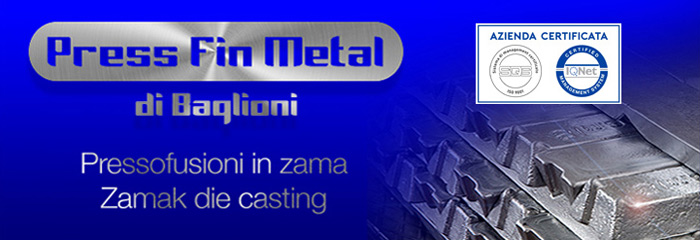
INFORMATION
ADVANTAGES OF ZAMAK DIE-CASTING
WHAT IS ZAMAK AND WHICH ADVANTAGES
THE ZAMAK DIE-CASTING OFFERS?
The alloy Zama, or rather, Zamak alloys were developed in 1929 by the New Jersey Zinc Company.
The name ZAMAK is composed by the German initials of the elements that compose the alloy, namely:
Z (Zinc), A (Aluminium), MA (Magnesium), K (Kupfer - copper)
In the early '30th Morris Ashby, in Great Britain, bought the license alloy ZAMAK from the New Jersey Zinc Company. The high purity zinc required for this alloy was not available in Europe, so Morris Ashby had the right to realize the alloy using zinc produced on site by electrolytic refining.
The use of the ZAMA in the dia-casting has several advantages:
- Resistance to shocks, wear and corrosion - The articles produced from die-casting zamak offer greater impact resistance and wear with respect to the articles produced with other alloys, or plastic, having zamak a hardness comparable to that of cast iron or brass. In addition, the corrosion resistance, in it self very good, is further increased if the items undergo a process of galvanic finishing such as zinc plating, chrome plating, nickel plating, satin finishing;
- Versatility in finishing the articles - The high precision of the articles die-casted in zamak simplifies the process of painting, varnishing, or polishing and plating, and even silver or gold plating;
- High accuracy of the castings - The characteristic ductility of the zamak, along with its good strenght, allow to have a great flexibility in the design of small parts and details. Compared to other alloys used for die casting, such as aluminium and magnesium, with zinc alloys it is possible to obtain closer tolerances and better finishes in die casted articles. PressFinMetal is able to produce articles in zamak with a weight varying from a dozen of grams to more than two kilograms;
- Saving - The articles die-casted using zamak are less expensive than those produced with other alloys;
- Production cycle with low impact on the environment - During the die-casting process, the ZAMAK, being an alloy of zinc, does not disperse in the air or in the environment any substancs that cause pollution. Furthermore, since the melting point of the zamak is at only about 410/420° C, it allows a considerable energy saving;
- Recyclability - All items made with die-casted zamak are recyclable.
For which kind of product is Zamak suitable?
Some common uses of this alloy: automotive, car parts, components and accessories for furniture, handles and components for appliances, faucets and taps for bathroom furniture, shower hinges, handles for hot tubs, valves and pneumatics, furniture and interior lighting, door handles, toys, ornaments and artistic, mechanical components, funerary art and objects, clothing and fashion accessories.
The different types of ZAMAK alloys
Today's characteristics of zamak are the result of nearly a century of research and studies carried out by various international companies, with the aim of identifying the most appropriate alloys for different uses.
Typical charecteristics of the main types of zamak
- zamak 12 offers high tensile strength;
- zamak 13 offers high impact resistance and corrosion resistance;
- zamak 15 is a zinc alloy of high quality with many advantages: it is comparable to the zamak 12 as regards the tensile strength and the zamak 13 with respect to the corrosion resistanc and impact strangth.
Zamak die-casting: let's explain it
The ingots of zamak are melted in an furnace at about 420°C adjacent to the die-casting machine, and the alloy is injected into a mould. Thanks to the high fluidity and low melting point, zamak allows to obtain pieces with very low tolerance limits and, at the same tima, complex and articulated shapes.
Die-casting in zamak instead of other materials: why?
It's unlikely that these pieces could be produced using other alloys, unless lacking in precision and tolerances to maintain; or impact resistance, or, in other cases, having a much higher cost of production and of the subsequent processing. In fact, to do machining or turning operations, to polish and finish a piece in Zamak is cheaper than to do the same, for instance, on a piece made of brass.
Another advantage is that the moulds for zamak die-casting have a duration of hundreds of thousands shots; a mould for aluminium die-casting has instead a duration limited in time, and this involves a higher cost which must be calculated on each die-casted piece.
So, thanks to its simplicity of use, to the fast cycle and the low melting temperature, the zamak alloys are more and more often prefered to other alloys in various production fields: hardware, mechanical components, components for the automobile, for household appliances, in particular washing machines, dishwashers and refrigerators, bathroom and kitchen taps and handles, components for modern showers and Jacuzzi, handles for door and windows, lighting accessories for home and office, and even fashion accessories.
In conclusion, the zamak die-casting allows to obtain, at a good cost, pieces with accurate edges, durable in time, and of absolutely constant quality, both in small and in large productions.
Home - Menu - Machines - Eco&Green - HPDC School
History - Quality - Articles - Pictures - Contacts
©2024 PressFinMetal di Baglioni Tiziano & C. snc
Via
Divisione Acqui 13/15 25065 Lumezzane (BS)
Pressofusione in zama conto terzi
Zamak die casting
Produzione articoli in
zama
Disclaimer & Privacy
sito web
![]()




